EDITOR’S NOTE: Traveleater Elise Ofilada shares with us 20 of her favorite South Korean desserts. Be sure to try as many as you can on your next visit to Seoul!
With the country’s current cultural grip on music, beauty, and entertainment, South Korea hardly needs any introduction. These days, it’s like there’s no person on Earth that hasn’t heard at least one BTS song. The unending fanfare over K-Pop and K-Drama artists is more than proof that the Hallyu wave, even after all these years, is just as strong and vibrant as ever.
Seoul, in particular, as the nation’s capital, has become a go-to destination for the average traveler. When I visited the city in 2017, I was already among the millions of tourists who excitedly explored its streets. From the scenic Cheonggyecheon River to the impressive Deoksugung Palace, I remember thinking that Seoul was one of my favorite places of all time!
But, aside from getting to visit many markets and historic sites, the best part about my trip to South Korea was all the Korean dishes and street food I was able to try. It’s definitely hard to go wrong with meals like cheesy street food lobster and spicy octopus with rice!
That said, there’s no beating the sweeter side of the Korean culinary experience. With ingredients ranging from shaved ice to sweet red bean paste, traditional Korean desserts are as delectable as they are versatile.
KOREAN DESSERTS QUICK LINKS
If you’re traveling to South Korea and want to really dive into Korean cuisine, then you may be interested in taking a cooking class.
TOURS & OTHER SERVICES
- Cooking Classes: Cooking Classes in South Korea
- eSIM: South Korea eSIM
Save This on Pinterest!
No time to read this article on the most delicious Korean desserts? Click on the save button and pin it for later!
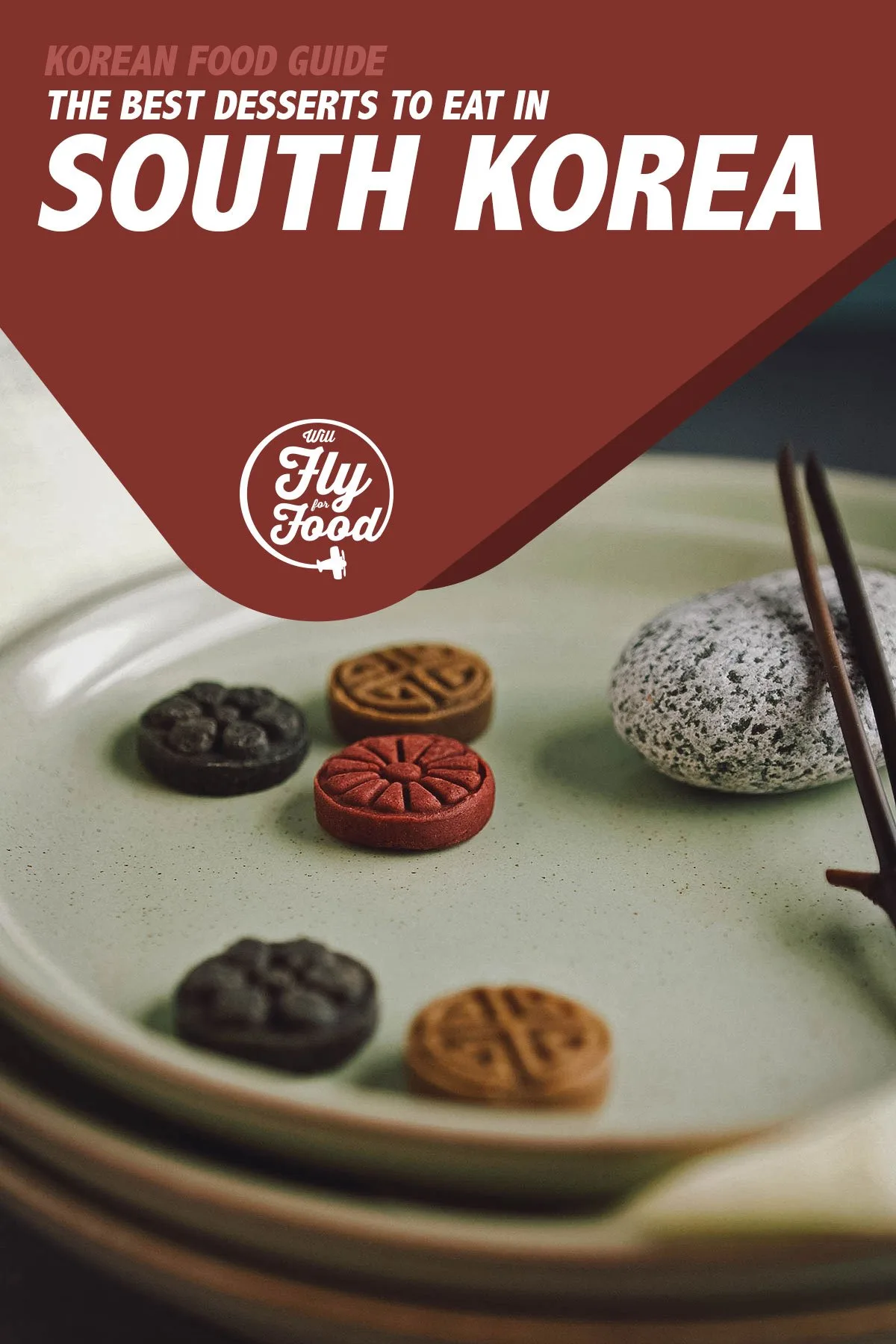
Photo by Image Republic
MUST-TRY TRADITIONAL KOREAN DESSERTS
1. Jeolpyeon
This Korean rice cake (or tteok, as they’re traditionally called) is known for its decorative patterns that are made using either wooden, ceramic, or bronze rice cake stamps. Though the plain version of jeolpyeon is prepared by steaming and pounding non-glutinous rice flour, it can be infused with other ingredients – like mugwort powder – to add various flavors and colors.
Before being served, jeolpyeon is also brushed with sesame oil to prevent the sticky rice from clinging to each other, giving the dessert a subtle nutty taste. With a smooth, but stretchy consistency, these rice cakes make for a real sweet treat during special occasions, like weddings and tea ceremonies.
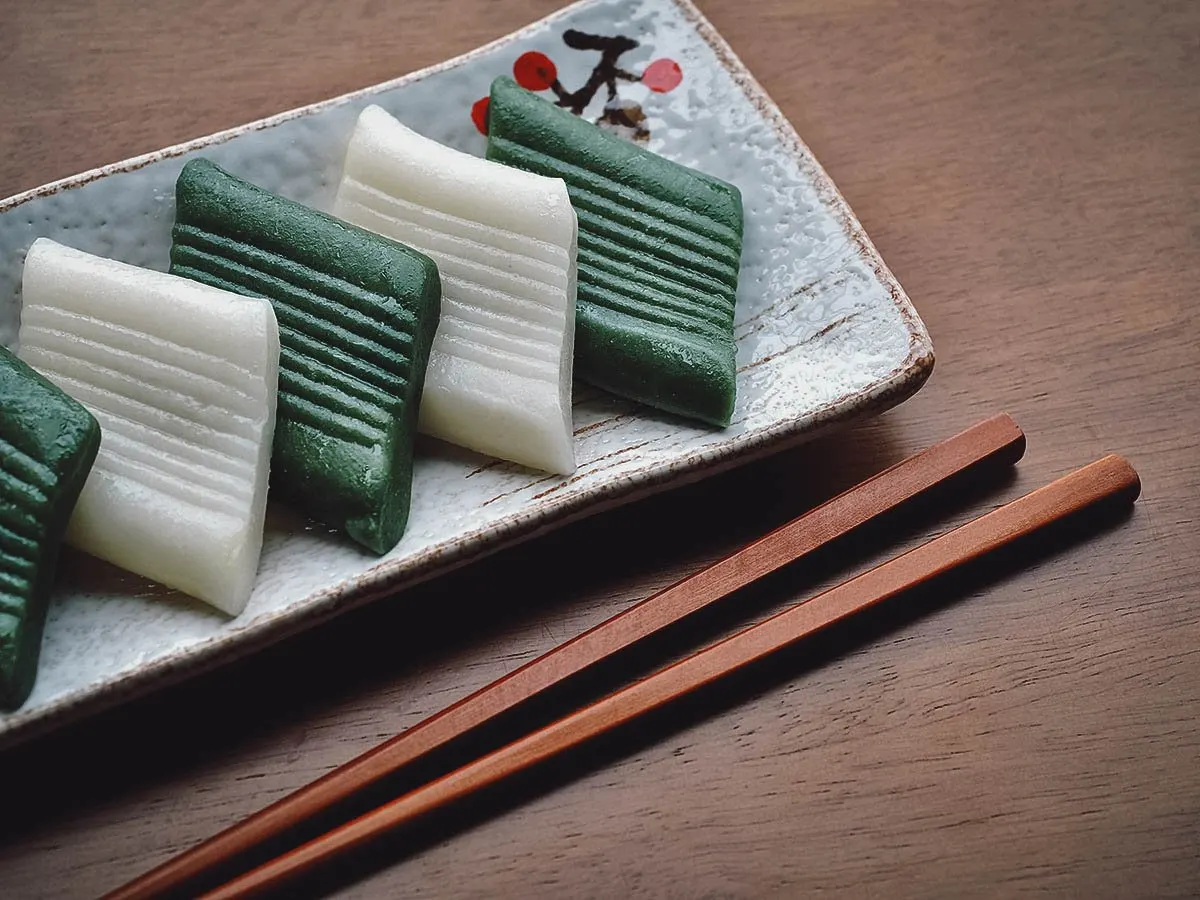
Photo by sungsu han
2. Songpyeon
Songpyeon is another kind of rice cake that is traditionally served during the Chuseok festival. This comes as a way for Korean families to give thanks to their ancestors for blessing them with an abundant harvest. The rice cakes are typically shaped like half-moons as a symbol of oncoming luck, which is also why many Koreans make wishes while eating them.
The chewy texture of this sweet rice cake comes from the dough (made from non-glutinous rice flour) being steamed over pine needles (song meaning “pine tree” in Korean, hence the name). Fillings like sesame seeds and sweet red beans are often used but sometimes vary per region.
If you’re in South Korea during Autumn, don’t hesitate to enjoy this Korean dessert!
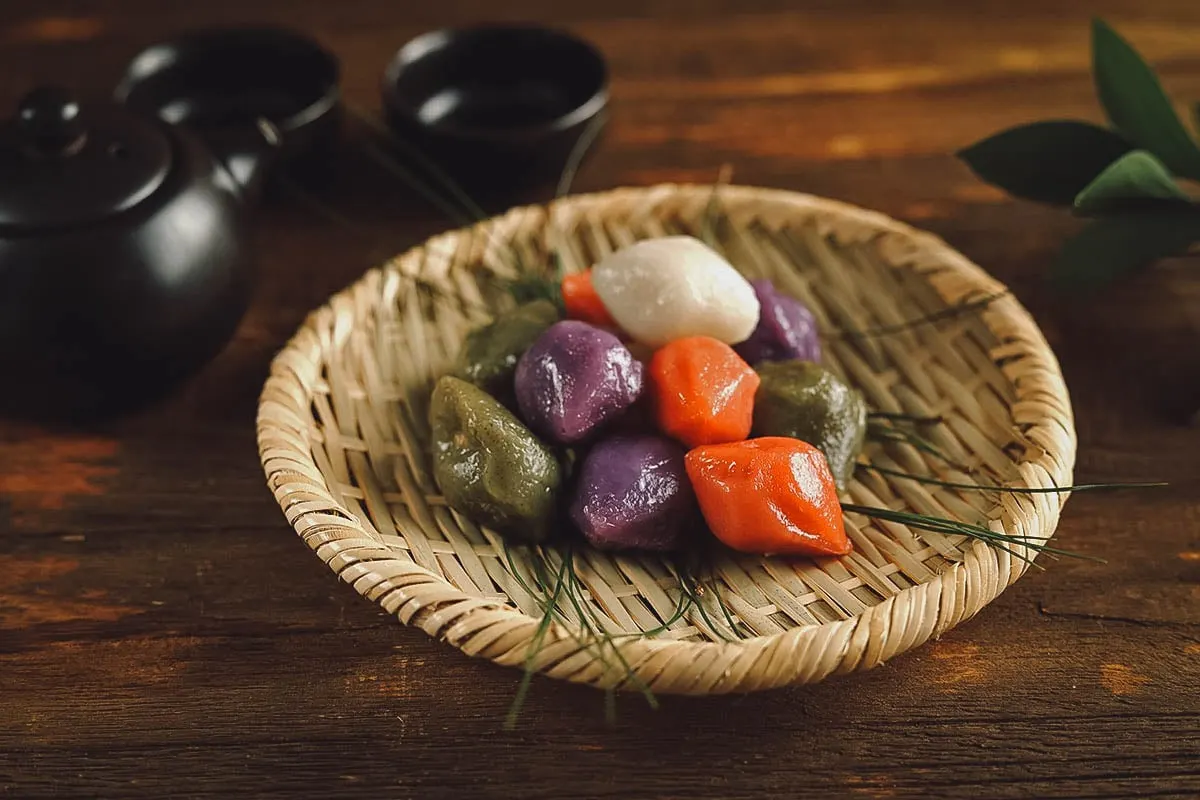
Photo by E Dewi Ambarwati
3. Jeungpyeon
Just like jeolpyeon and songpyeon, jeungpyeon is a traditional Korean rice cake. It’s commonly prepared during Korea’s Dano festival or eaten during the summer. However, this dessert has a special ingredient that really sets it apart— its dough is mixed with makgeolli or Korean rice wine!
This alcoholic addition gives the rice cakes a soft, bubbly texture when it’s finally steamed and served. It can also be topped with various garnishes, like jujubes, chestnuts, and chrysanthemum petals.
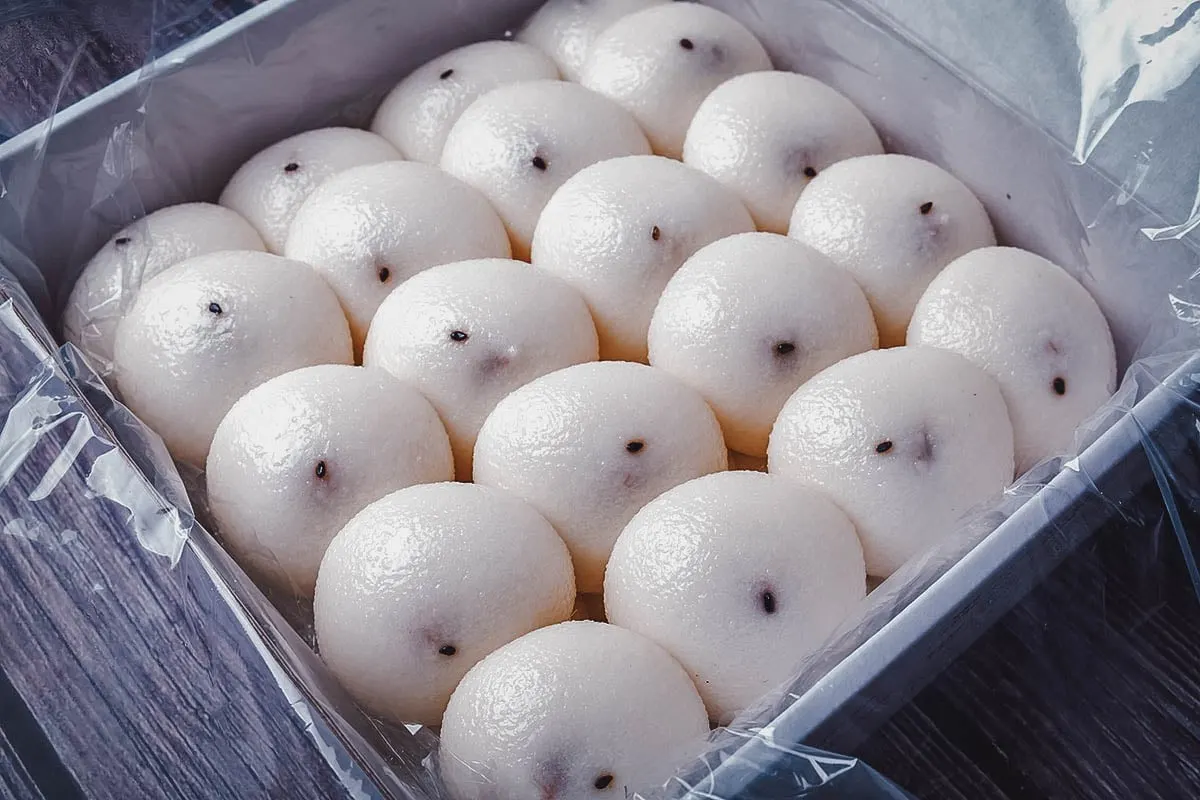
Photo by becky’s
4. Chapssaltteok
Known as the Korean mochi to older generations (as it’s probably derived from the famous Japanese dessert), chapssaletteok is a rice cake stuffed with sweet red bean filling. Its texture is both soft and chewy when you bite into it, thanks to the dessert’s outer portion being made of glutinous rice.
Chapssaletteok comes in a variety of colors, such as white, pink, and green. Ingredients like red food coloring and green tea powder are used to achieve this.
These Korean rice cakes are usually served during the winter season and are also given to university students taking their entrance exams as a way of wishing them good luck.
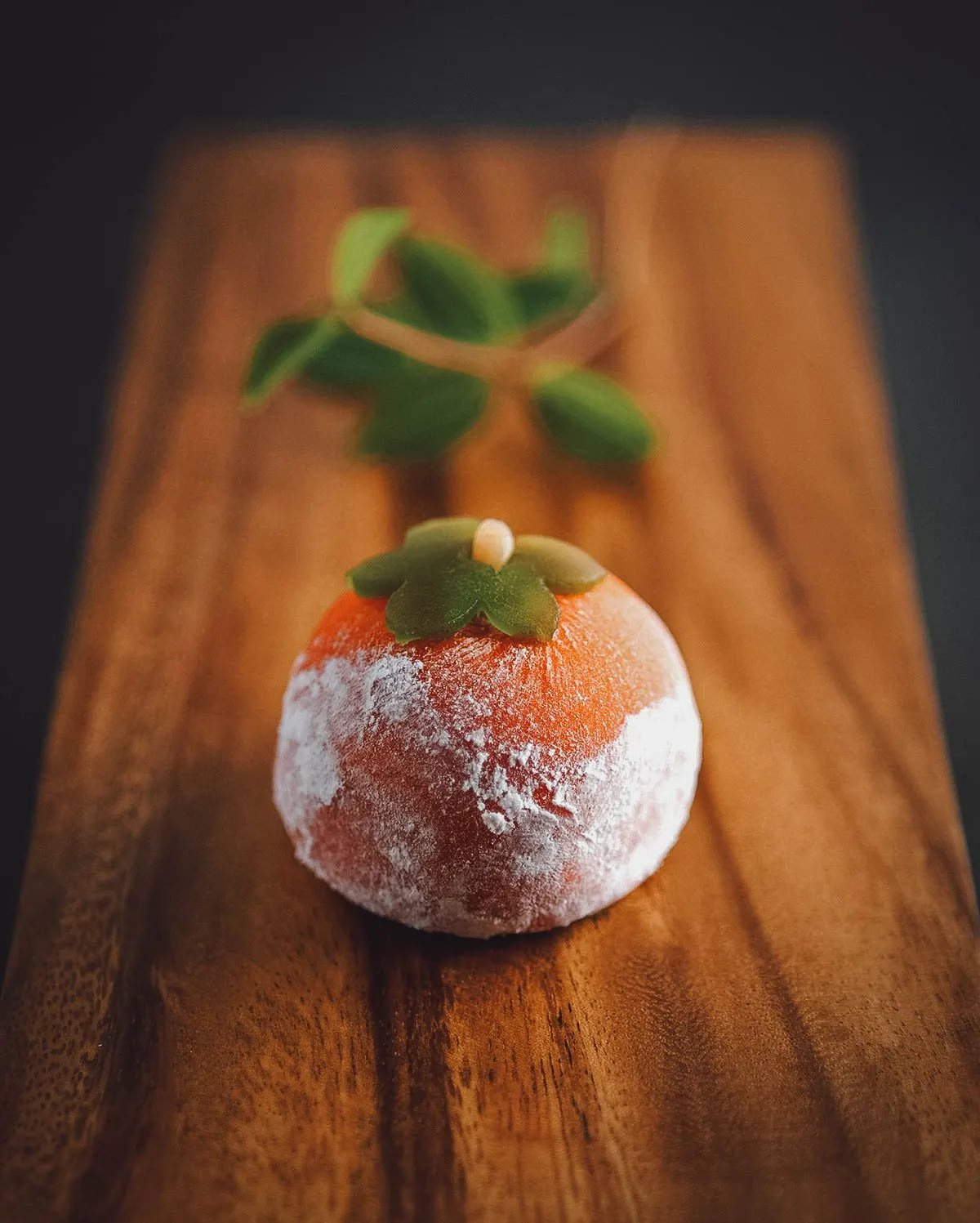
Photo by Image Republic
5. Injeolmi
As a very popular dessert, injeolmi is possibly the most well-known of all the Korean rice cakes. While it’s another sweet snack made from glutinous rice, it can be distinguished by its dusting of soybean powder. That said, toppings like black sesame seeds, chopped pine nuts, and mashed red beans are also welcome, as they add complexity to the rice cake’s texture.
Additionally, injeolmi is known for its sticky texture. Because of its stickiness, it’s commonly gifted to newlyweds in the hopes that they will always “stick together”. Now, if you’re ever at a loss as to what to give your friends when they say their vows, why not order a batch of this delicious treat for their special day?
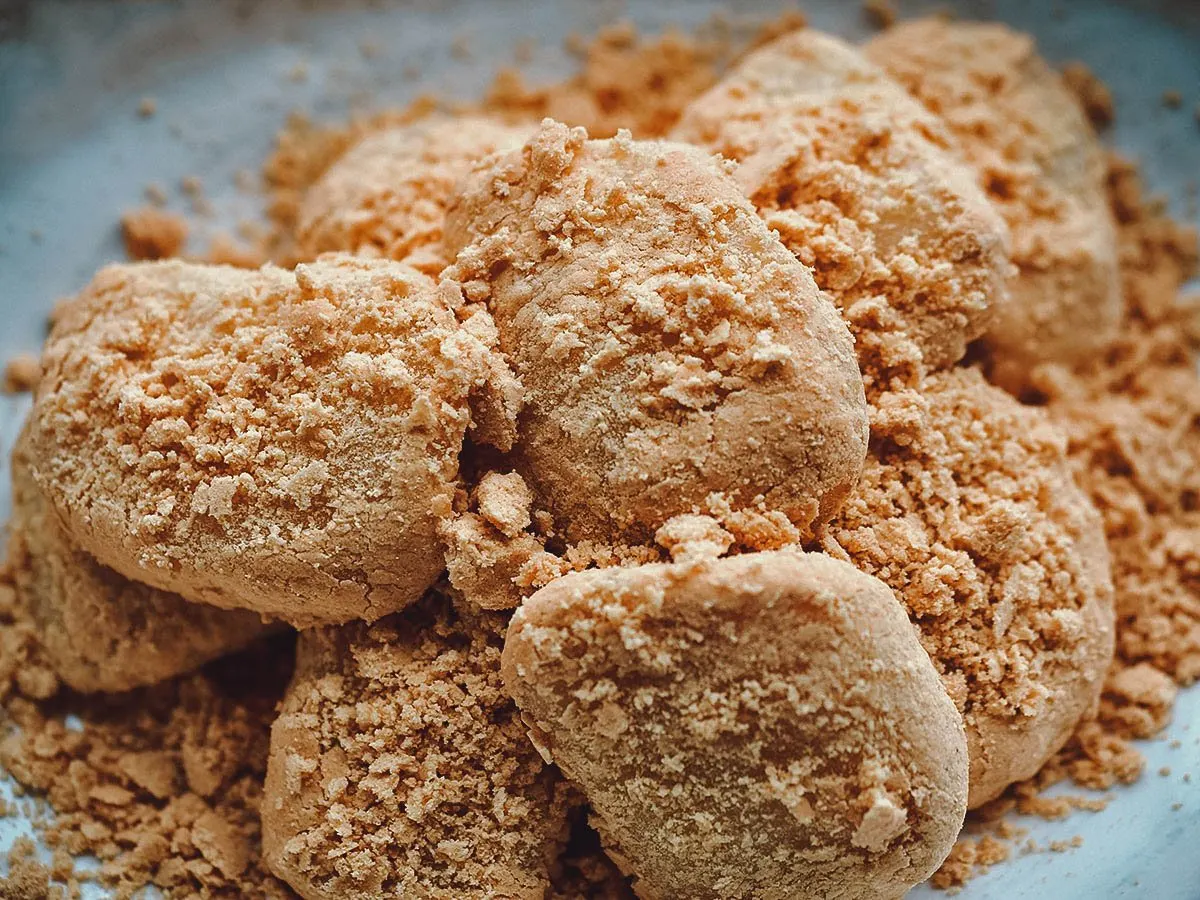
Photo by sungsu han
6. Bukkumi
Though bukkumi originates from the Gangwondo province, these pan-fried rice cakes are also much-loved in Seoul. The dessert boasts both a gooey filling made of either sweet red beans or mung bean paste, and a crispy exterior that’s generously doused with honey syrup.
Made with (you guessed it!) glutinous rice flour, these rice cake dumplings are the kind of delicious dessert that instantly makes your mouth water. With its perfect balance of flavors and contrasting textures, I promise that you won’t regret grabbing one on your next trip to Korea.
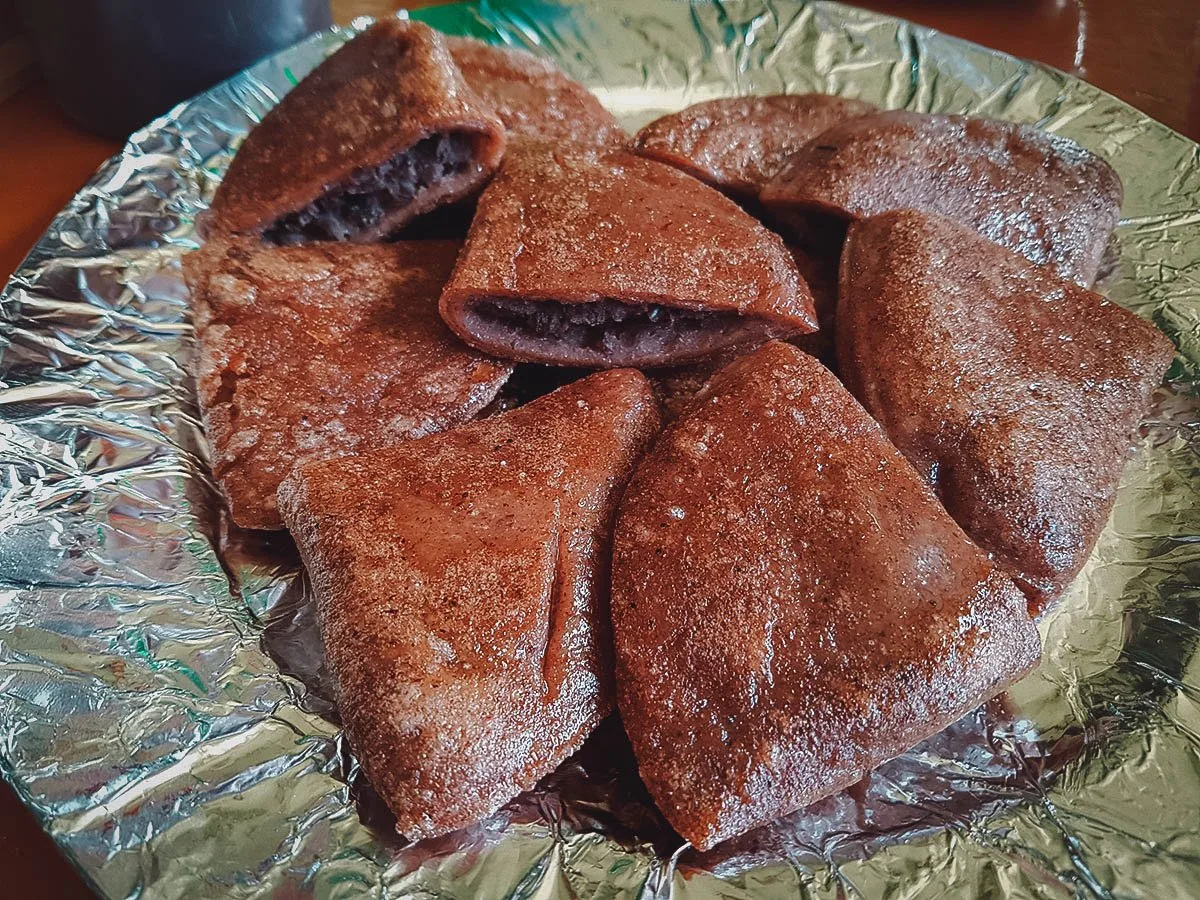
Photo by miru.namu
7. Yakgwa
With a name that stands for “medicinal confection” (due to honey being a prominent ingredient in ancient Korean medicine), yakgwa or Korean honey cookies might not sound all that appetizing. Don’t let its name put you off, though! This flower-shaped pastry is tastier than you might think, especially when it’s prepared on special occasions and paired with tea.
Traditionally, yakgwa’s dough is made with ingredients like wheat flour, ginger juice, and sugar syrup. It’s cut into different sizes (i.e., small, medium, and large), deep fried, soaked in honey, and dipped in cinnamon powder.
If you’re ever craving for a piece, but don’t want to wait in line at a teahouse, yakgwa can also easily be found in an average Korean grocery store.
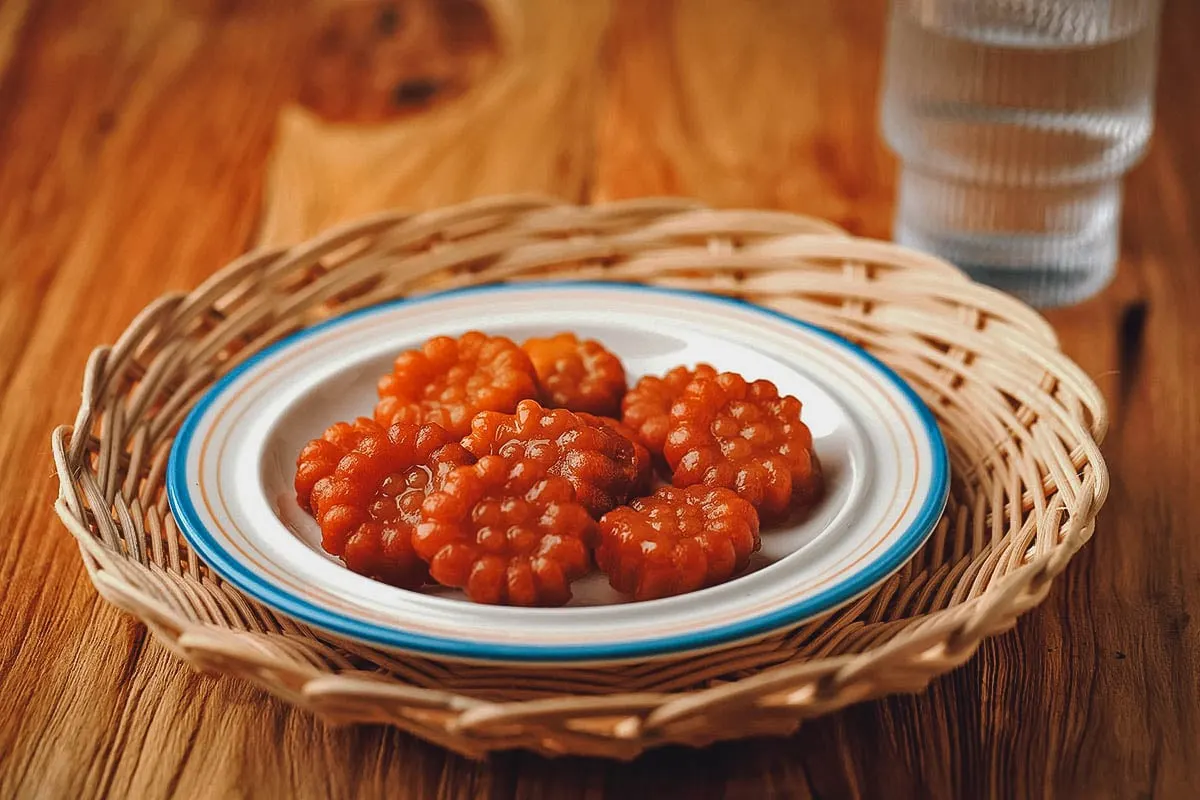
Photo by Ika Rahma H
8. Dasik
Speaking of tea, dasik are bite-sized, gluten-free Korean tea cookies that were introduced by China to the Korean dynasty. They have a light, earthy, and sweet taste, owing to the fact that their finely ground, all-natural ingredients are mixed with honey.
A wooden or porcelain press (called daskipan) is used to embellish the cookie with a design or pattern that symbolizes wishes for good luck, health, happiness, etc. Typically, a plate of these cookies will come in an assortment of colors (namely green, yellow, pink, black, and white), each representing a different flavor.
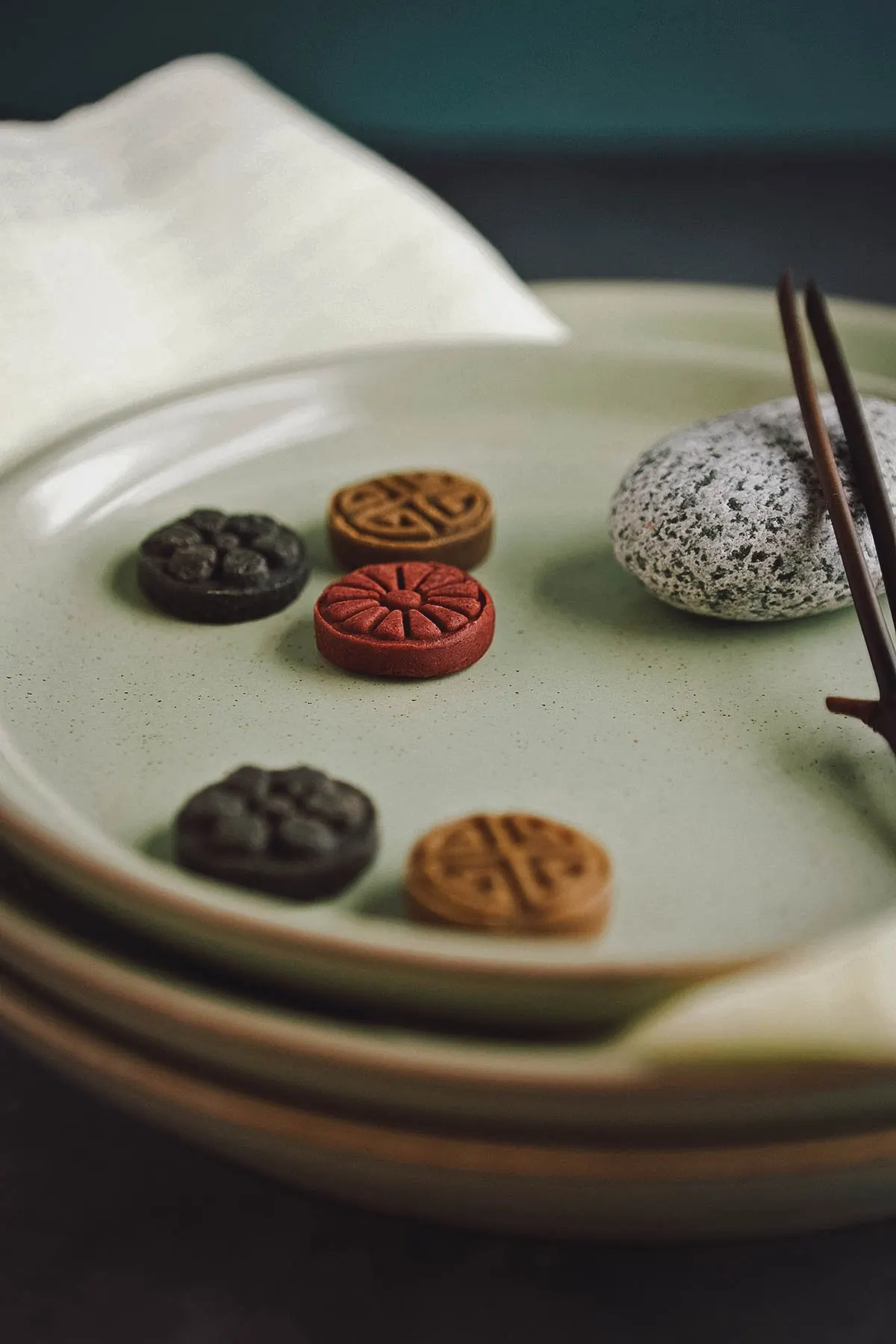
Photo by Image Republic
9. Goguma Mattang
Crunchy on the outside, but tender on the inside, this sweet and savory dessert is best enjoyed during fall or winter.
Goguma mattang, also known as candied sweet potatoes, features deep-fried Korean sweet potatoes coated in caramelized sugar. The dish is said to have originated from China, but evolved in technique once it came to Korea.
It’s also similar to a Japanese dessert called daigaku imo and pairs well with a warm cup of tea.
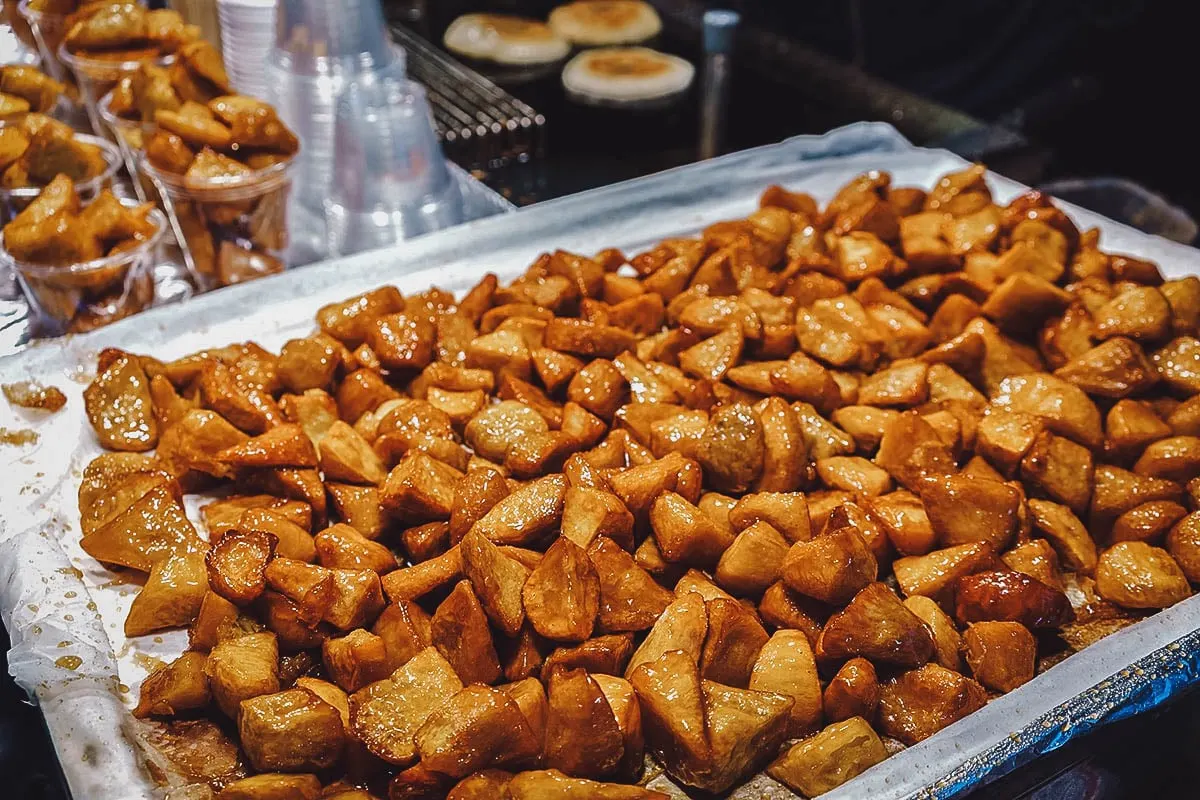
Photo by PK289
10. Gotgamssam
Involving only two ingredients, gotgamssam is prepared through what is probably one of the easiest Korean dessert recipes out there.
The simple snack is essentially made up of walnuts that are tightly wrapped in dried persimmons. The combination makes for a lovely snack to share with house guests, especially for those who avoid eating gluten or too much sugar.
Don’t forget to ask for some if you’re visiting a Korean friend at home!
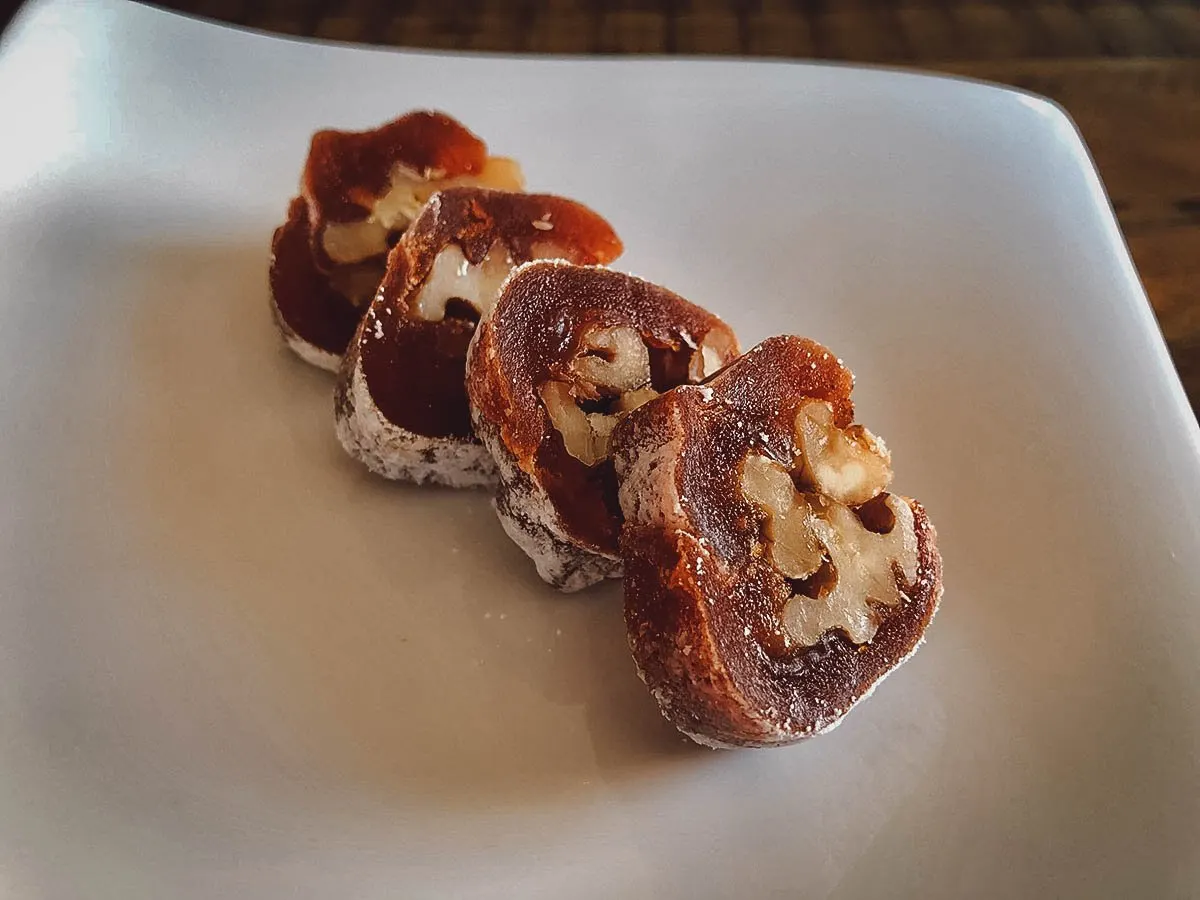
Photo by nickichen
11. Hodu-gwaja
Though originally created in 1934 by a couple who lived in the city of Cheonan, this tasty dessert was only popularized in Seoul during the 1970s.
Essentially, hodu-gwaja is a pastry that’s been filled with chunks of walnuts and red bean paste. Nutty on the inside and out, its dough is prepared with pounded walnuts mixed with wheat flour.
You can often find this treat at Korean train stations or rest stops.
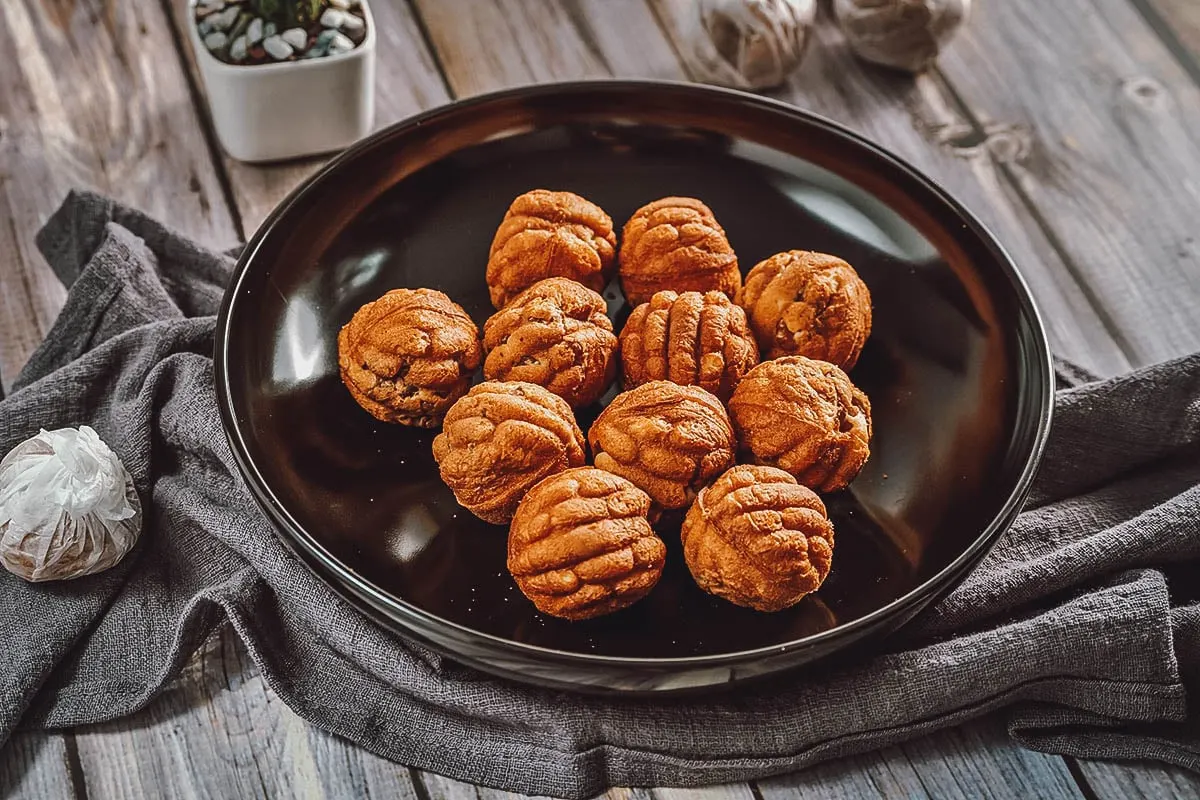
Photo by CHALLA_81
12. Yeot Gangjeong
One of the many Korean desserts eaten during the holidays, yeot gangjeong can be described as a candy bar that’s primarily made of chopped, unsalted nuts (though other ingredients, such as toasted seeds and beans, can also be included). The bar is held together by mullyeot (Korean rice syrup), which makes the treat sticky, but not too sweet.
Traveleaters looking for a light, but tasty snack are sure to love munching on yeot gangjeon.
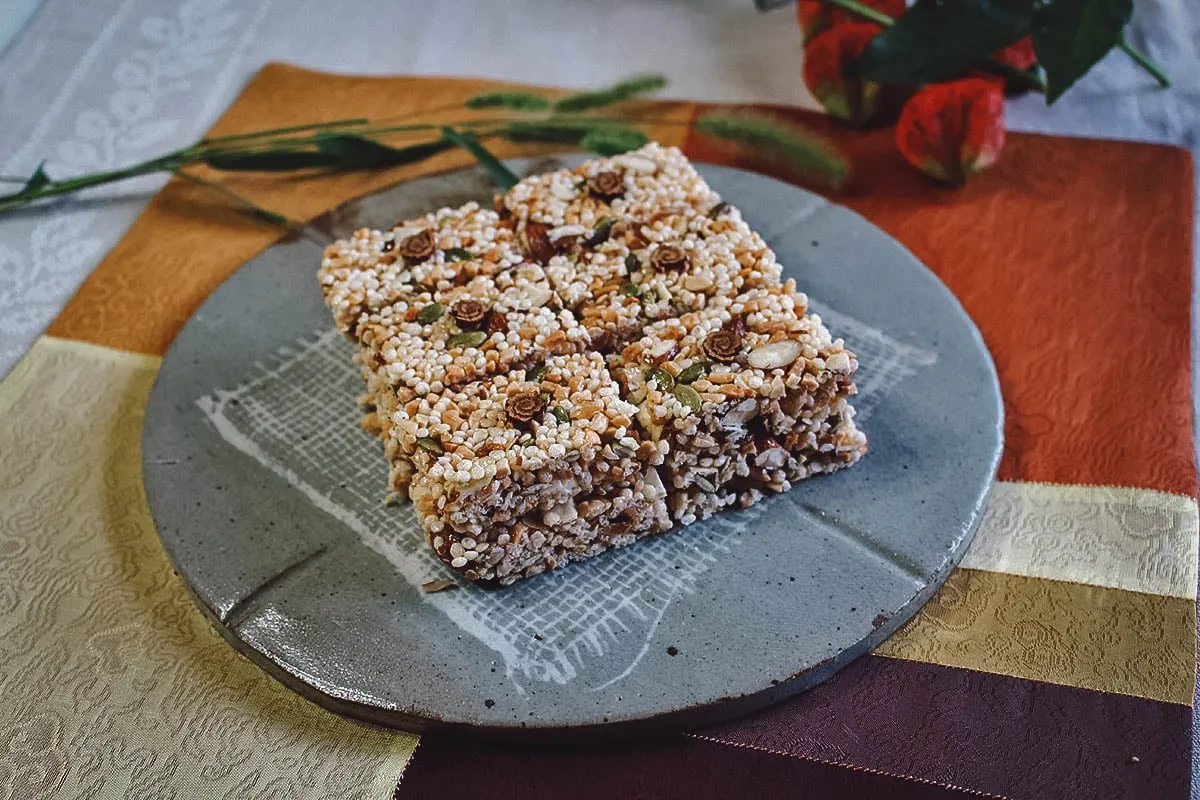
Photo by RJ Art
13. Dalgona
You might have already heard of this Korean dessert thanks to the hit Netflix series – Squid Games.
Often sold by street vendors to children, it’s a sort of honeycomb toffee that’s made by mixing, heating, and allowing sugar and baking soda to harden. The resulting candy is a flat, brittle disk with a sweet and smoky caramel taste that’s perfect for snacking on.
Additionally, while dalgona can be eaten as is, it’s usually embossed with a shape (like an umbrella, heart, or star) that you’d have to eat around without breaking. Many of the young and young-at-heart love to partake in this fun little challenge, sometimes with the help of toothpicks or pins.
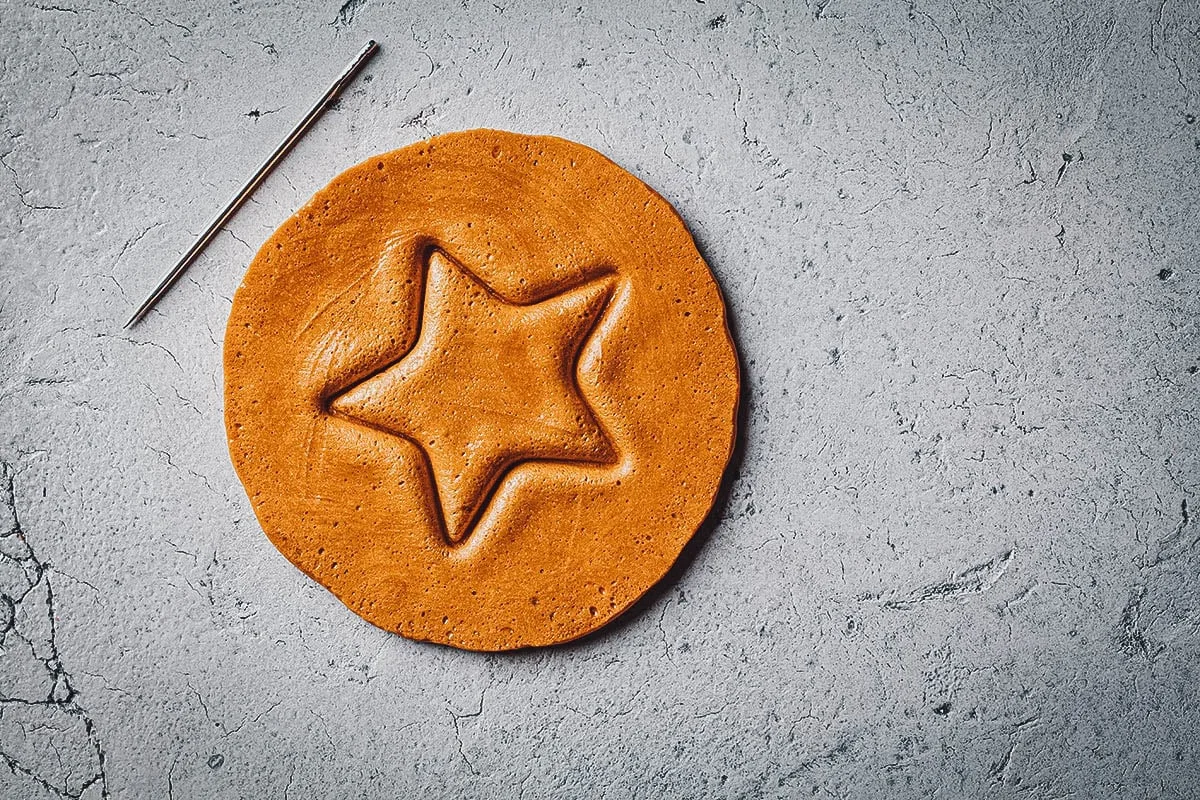
Photo by Nina Firsova
14. Bungeo-ppang
Bungeo-ppang is a Korean fish-shaped pastry that’s largely enjoyed during the winter.
If you’re feeling skeptical, no need to worry! Despite its appearance, it harbors no actual seafood flavors. In fact, its commonly loaded with sweet red bean filling inside (though some street vendors offer a variety of fillings).
Cooked in a special fish-shaped waffle iron and served hot, this delicious treat is sure to hit the spot during a cold adventure around the streets of Seoul.
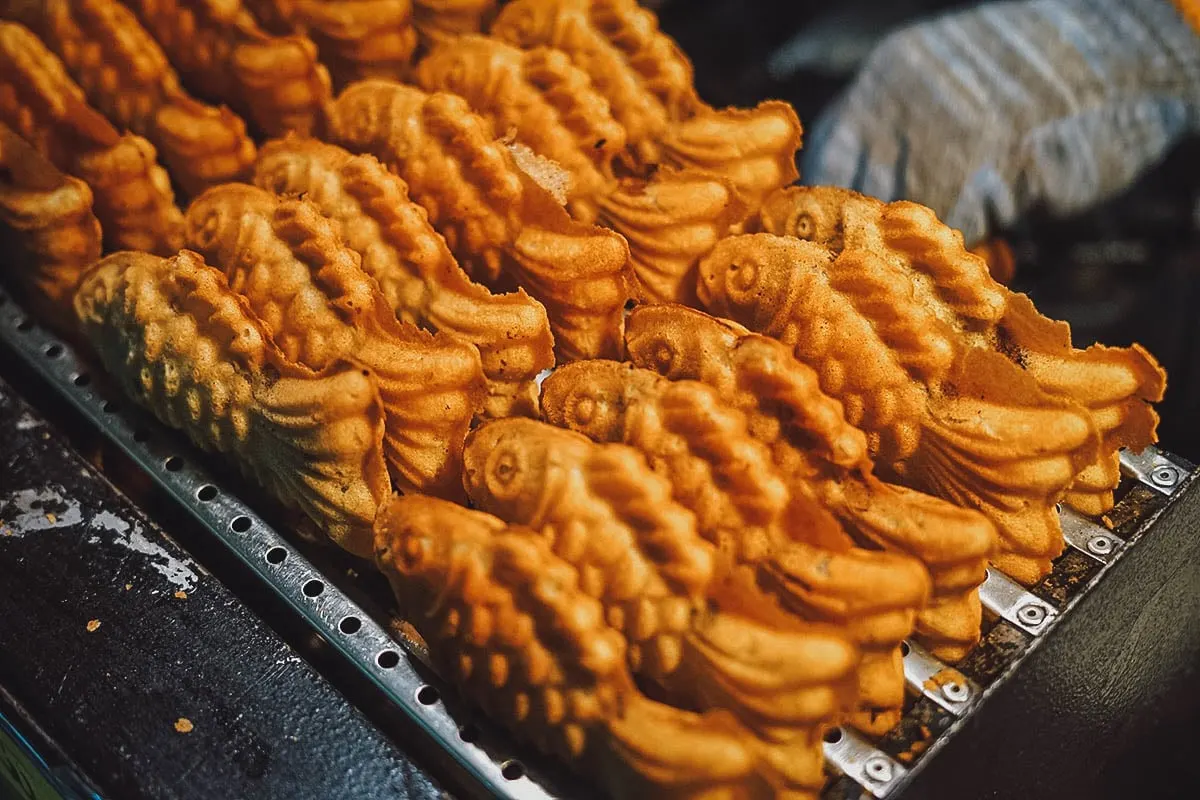
Photo by Izlan Somai
15. Honey Bread
One of the more modern Korean desserts that have become widely available, honey bread is a strong contender for the title of ultimate comfort food. The dish consists of a thick square piece of buttered bread that’s been pan-fried and finished off with toppings like whipped cream, ice cream, cinnamon, and (of course) a generous drizzle of honey.
Served frequently in cafes all across the country, honey bread is bound to satisfy any sweet tooth’s cravings. While you could surely share a plate of the sweet treat with a number of your travel buddies, I’d recommend devouring a whole serving all by yourself!
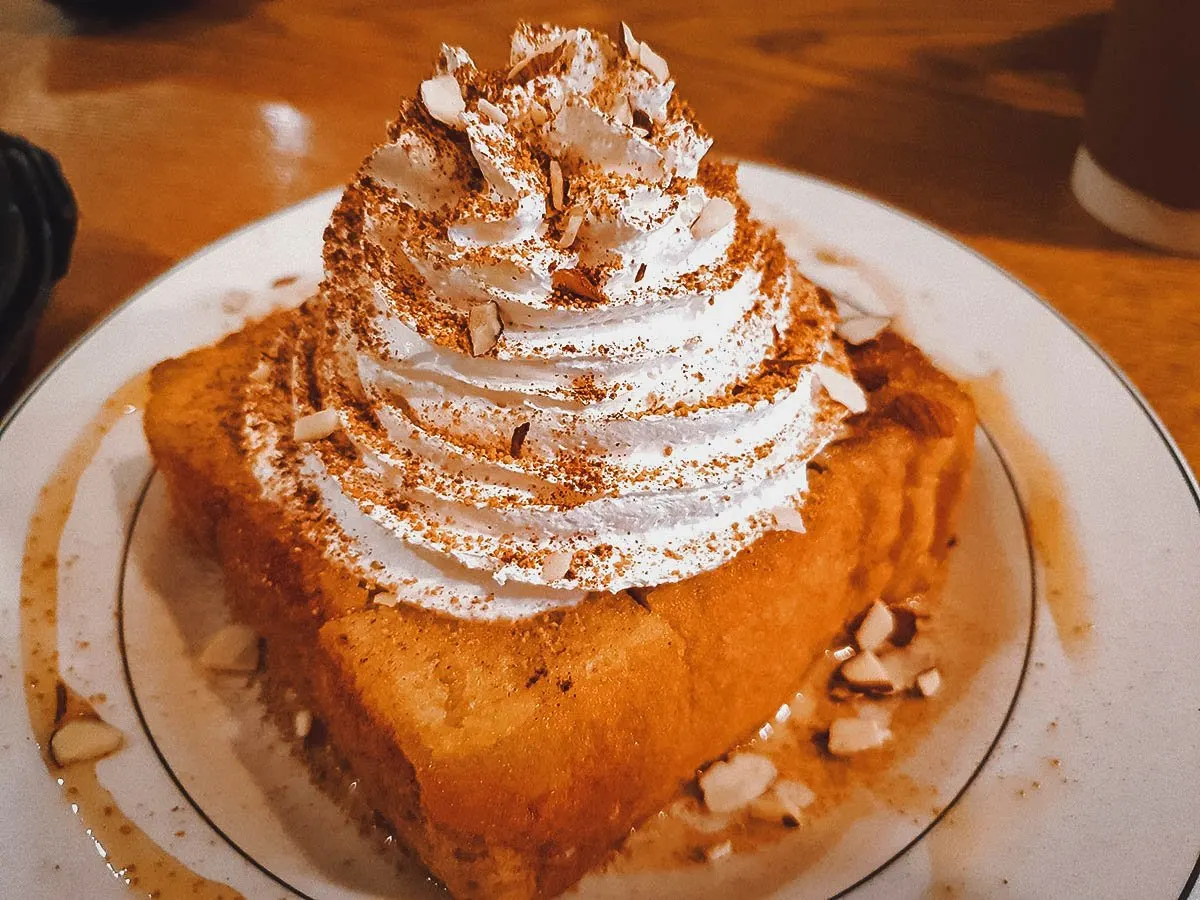
Photo by Sonim
16. Kkwabaegi
Your experience of Korean desserts wouldn’t be complete without a taste of kkwabaegi. Fortunately, a fresh batch of these twisted doughnuts can be easily found in the average neighborhood bakery or at a street vendor’s stall.
With a fluffy and spongy texture that’s best enjoyed while warm, it’s a snack that will have you hooked on your first bite. Kkwabaegi is often dusted with powdered sugar and also pairs great with a tall glass of milk.
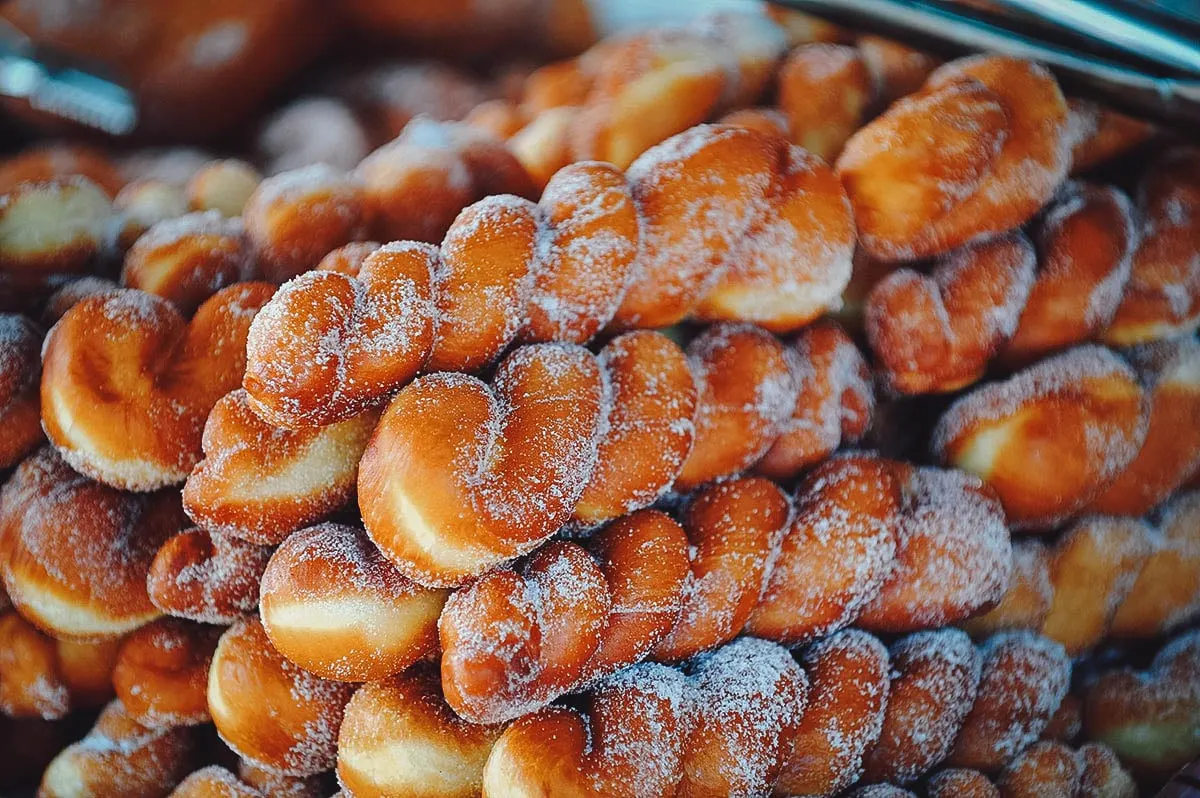
Photo by Yeongsik Im
17. Bingsu
Bingsu, a traditional Korean shaved ice dessert, is one of the best dishes to eat during the hotter parts of the year. Traditionally topped with sweetened condensed milk, a variety of fruits, red beans, and the like, bingsu can be customized to suit even the pickiest Traveleater’s taste.
From injeolmi to persimmons, melons to mangoes, the possible flavor profiles of the dessert are endless. More modern restaurants and franchise chains sometimes add less traditional ingredients, like yogurt, coffee, and matcha powder.
Personally, my favorite type of bingsu is loaded with chocolate!
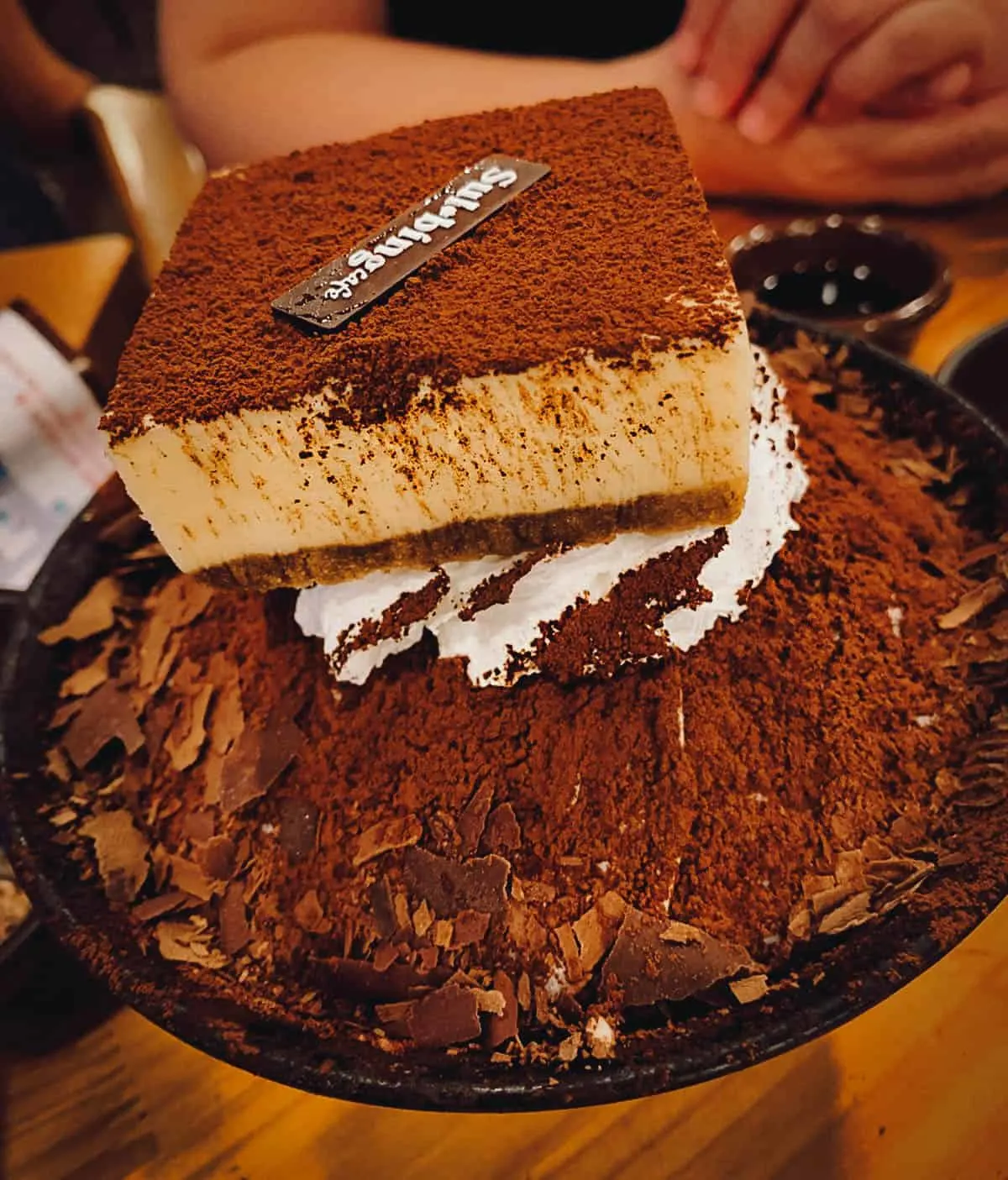
18. Hwachae
A traditional Korean drink that’s typically prepared during the hot seasons, hwachae is a kind of punch that’s made with fresh fruits or edible flower petals. It’s traditionally made by soaking the fruits in either honeyed water or magnolia berry juice, though modern versions use carbonated drinks instead.
This refreshing drink should be served in a glass bowl and ladled with a spoon for maximum summer vibes. Remember to take a sip before you go out and explore Seoul’s many attractions.
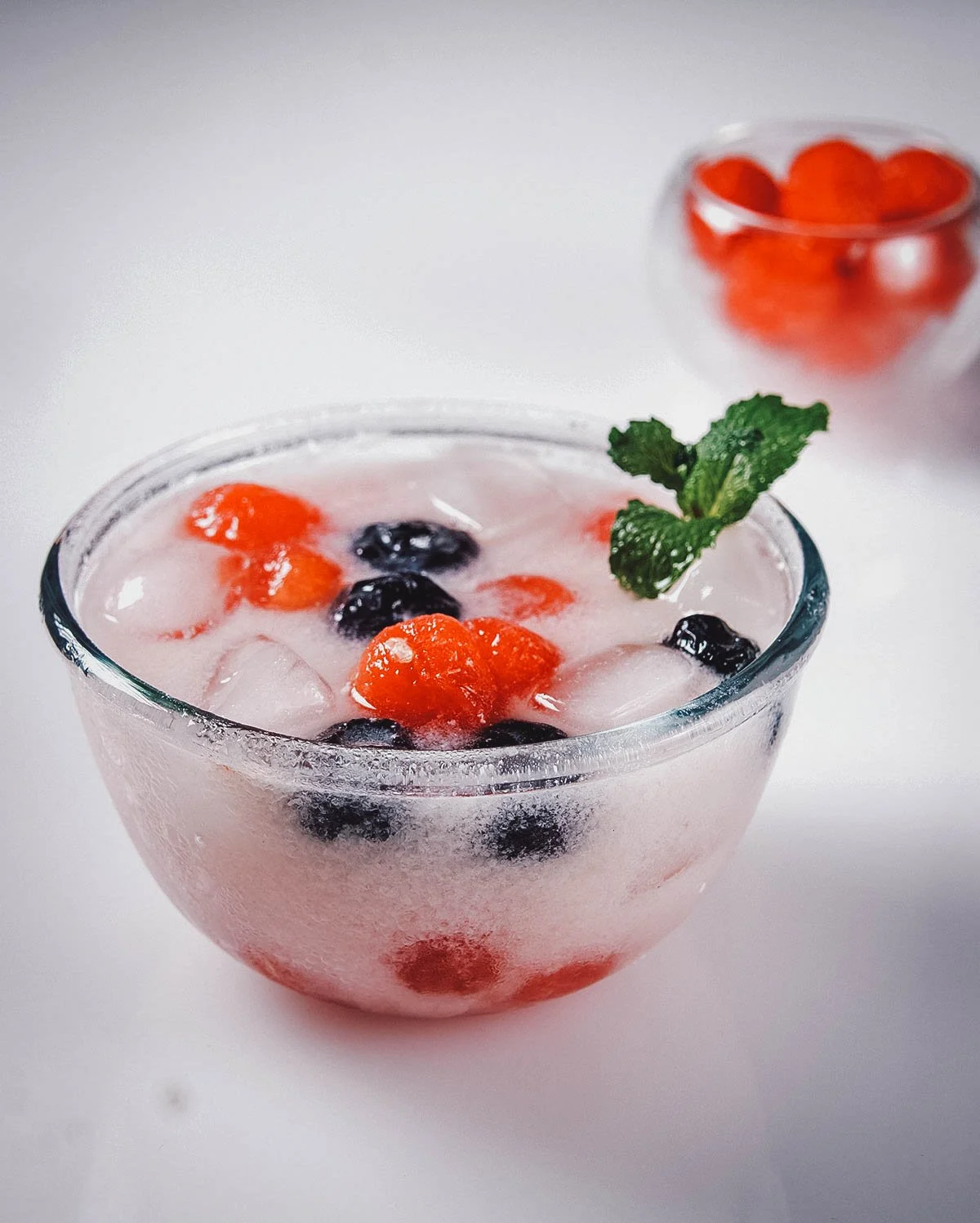
Photo by sri widyowati
19. Melona
One of the first modern Korean desserts I ever tried was Melona, a staple in convenience stores even outside of South Korea. Because of its delicious creamy flavor, I quickly learned that there’s no need for mountains of shaved ice, or even an overly fancy ice cream machine, when you’ve got this pastel-colored rectangular popsicle waiting for you in the freezer.
The famous ice cream is most known for its melon flavor, though it comes in other fruit flavors as well (e.g., strawberry, banana, mango, etc.). A product of the Binggrae company, it’s a sweet treat that can be enjoyed by Traveleaters of all ages.
Just a warning, though: Once you try a stick, it can get pretty addicting. So, when you find yourself at your local Korean market, always remember to grab two or more!
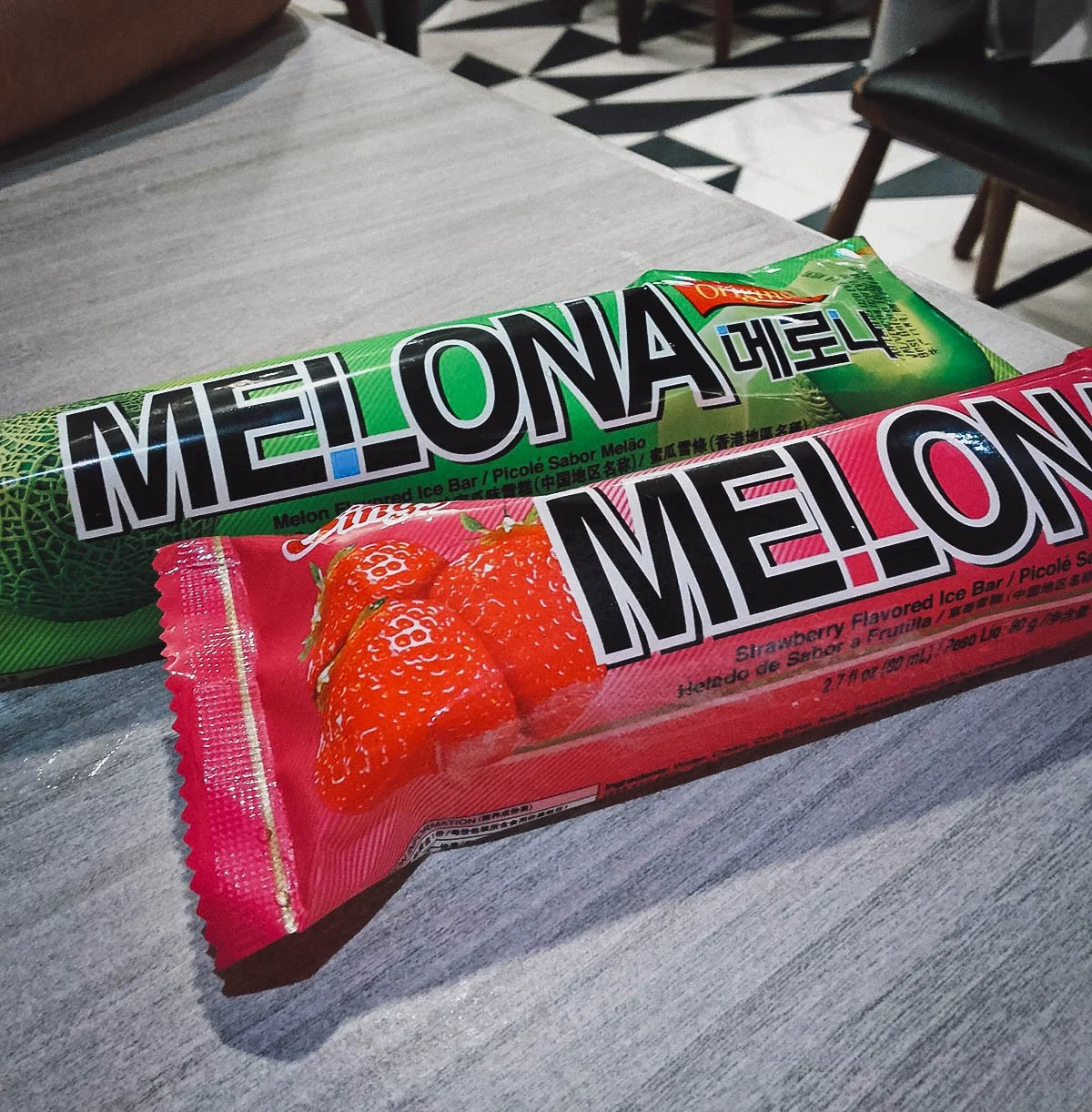
“Melona Ice Cream” by John Ong, used under CC BY 2.0 / Cropped, Processed in Photoshop and Lightroom
20. Sujeonggwa
Capping off our list of delicious desserts is sujeonggwa, a Korean cinnamon punch. This dessert drink is known for its cinnamon-and-ginger-y fragrance, achieved by boiling the ingredients with a mixture of brown sugar and water.
Garnishes, such as pine nuts and dried persimmons, are likewise added to the liquid to give the punch the right hint of fruitiness. Additionally, the punch is known for its health benefits, like helping with better digestion and fighting off common colds.
Whether it’s served hot or cold (depending on your preference), you can definitely expect a special drink like sujeonggwa to always do more than just quench your thirst.
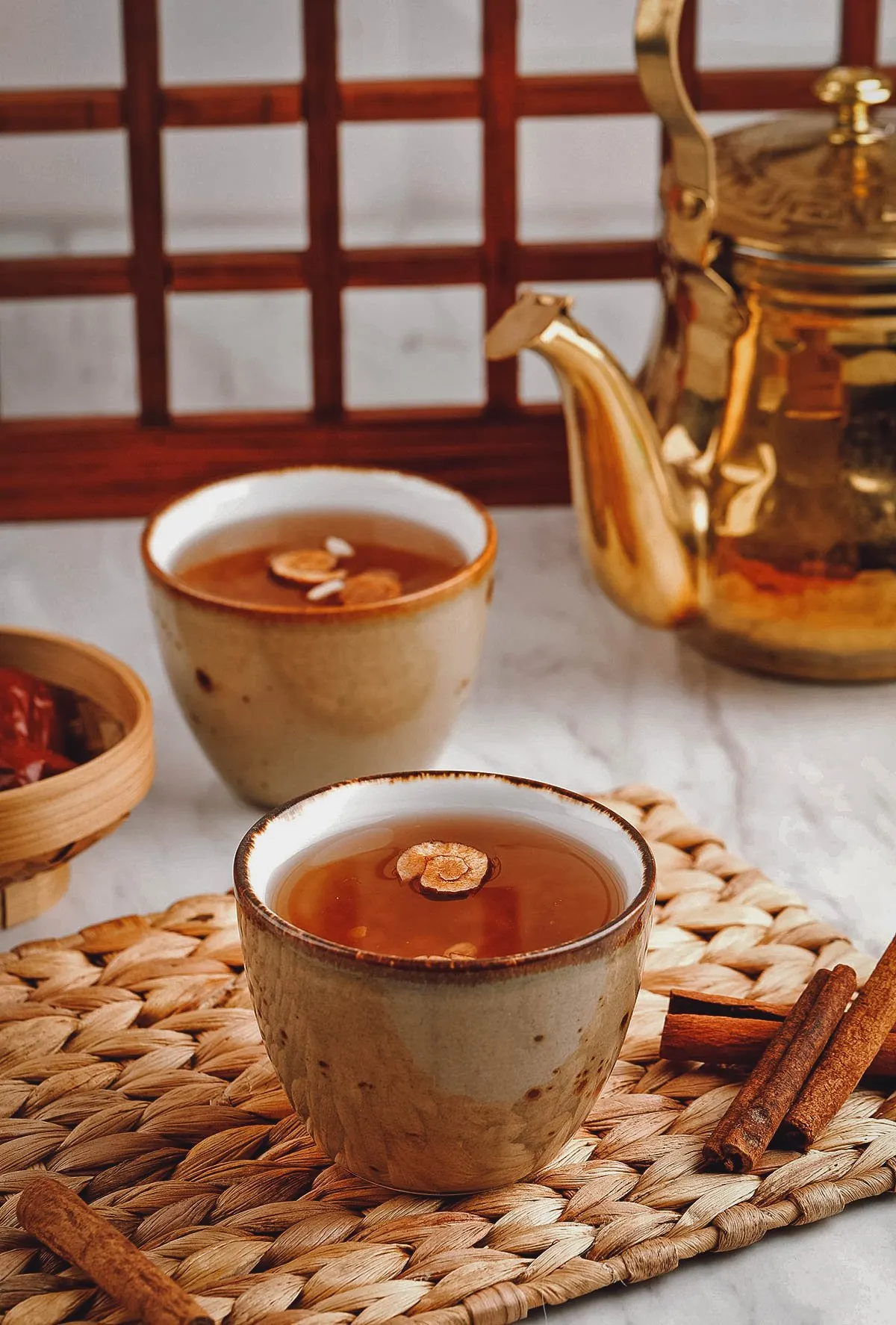
Photo by Ika Rahma H
FINAL THOUGHTS ON KOREAN DESSERTS
Food is an aspect of Korean culture that is widely celebrated all over the globe. Online, there are millions of blogs, videos, and social media accounts that are dedicated to showcasing the country’s amazing cuisine.
With desserts, specifically, there’s no overstating just how much people love what South Korea has to offer. Be it shaved ice, rice cakes, or doughnuts, you will be bombarded with unending vouches for their delicious flavors.
So, when you’re out for a night of soju and K-BBQ, don’t forget to save some space – you never know what sweet treat could be waiting for you in the cafe across the street!
In the end, a visit to Seoul would be incomplete without a taste of its delightful desserts.
Disclosure
This article on Korean desserts contains affiliate links, meaning we’ll earn a small commission if you make a booking at no added cost to you. As always, we only recommend products and services that we use ourselves and firmly believe in. We really appreciate your support as this helps us make more of these free travel and food guides. Thank you!
Cover photo by Nina Firsova. Stock images via Shutterstock.

